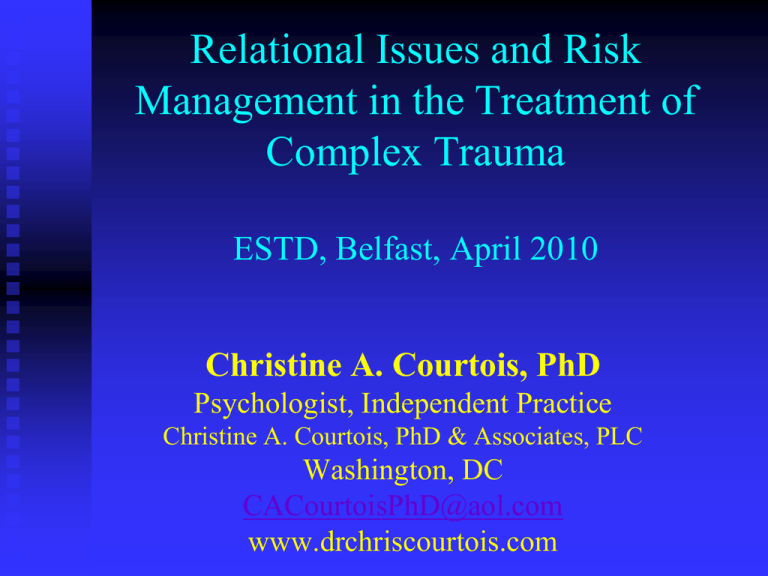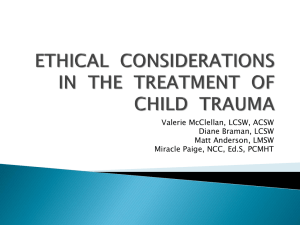Responsible Practice: Risk Management for Trauma Therapists
advertisement

Relational Issues and Risk Management in the Treatment of Complex Trauma ESTD, Belfast, April 2010 Christine A. Courtois, PhD Psychologist, Independent Practice Christine A. Courtois, PhD & Associates, PLC Washington, DC CACourtoisPhD@aol.com www.drchriscourtois.com Treating the traumatized: A vulnerable and high risk population n n n Complex PTSD/DESNOS: not in DSM u “PTSD plus” Most resembles BPD Challenges of treating complex trauma patients: u u u u u Relational deficits and attachment disturbances Life skill deficits/chaotic lifestyle Somatic/medical problems Risk: depression, anxiety, dissociation, self-injury, suicidality, revictimization, memory disturbances Intense transferences that trigger equally intense countertransference reactions/errors Current Atmosphere and Issues n n n n n n n Era of increasing liability Era of managed care Changes in professional ethical codes More stringent licensing and professional standards The delayed/false memory controversy Discoveries in the field of neuroscience, memory, attachment, psychotherapy practice Evolving science (evidence-based treatment) and standards of care for trauma treatment Science: The Evidence Base of Trauma Treatment n Ever growing for “simple”/classic PTSD sx u specific treatments: F F F F u CBT (prolonged exposure) CPT & other cognitive protocols EMDR others? applicable to complex trauma? F F F research generally excludes these patients research easier to conduct on CBT approaches and specific posttraumatic symptoms difficulty assessing multiple modalities Science: The Evidence Base of Trauma Treatment n Will some techniques hurt more than help? u A major ethical concern u u u u Potential for retraumatization? Treatment tailored to the individual Therapist must monitor response Apply most effective but safe strategy F informed consent/refusal The Evolving Standard of Care for Trauma Treatment n n n n Foa et al. (2000) Journal of Clinical Psychiatry Expert Consensus Guidelines (2000) ApA Treatment Guidelines for PTSD/ASD (2004) ISSD Treatment Guidelines for DD’s u u n Adults (1994; 1997; 2005) Children (2000) Delayed memory issues u Courtois (1999); Mollon (2004): overviews The Evolving Standard of Care for Trauma Treatment n n Psychotherapy and psychopharmacology in majority of cases Stage-oriented for the entire PTSD-DD spectrum; three stages: u u u n Early: safety, stabilization and functioning, skill-building: decrease symptoms, increase coping; therapeutic alliance Middle: trauma information and emotional processing Late: self and relational development Different trajectories u according to patient’s psychological make-up, tolerance and capacity, and resources Science: The Evidence Base of Trauma Treatment n Growing for complex trauma u critical role of the therapeutic relationship (the original evidence-based strategy) F F u relational healing for relational injury interpersonal neurobiology hybrid models of treatment F F F F F CPT (Resick) STAIR model (Cloitre) Seeking Safety (Najavits) and ATRIUM (Miller)-substance abuse DBT (Linehan)--BPD, affect dysregulation and skills TARGET (Ford) Definition of Risk Management in Therapy “Responsible clinical practice within the standard of care, which minimizes risk to patient and his/her significant others and to self as therapist” Responsible and Ethical Practice Framework “First, do no harm” Responsible and Ethical Practice Framework n For psychotherapy in general: Professional code of ethics, professional standards, and applicable state law u Professional business practices in keeping with the law (now HIPAA) and ethics/standards u Billing, record-keeping, confidentiality, staff F Emergencies and coverage F Framework (cont.) u Collaborative relationships Supervision and consultation F W/ prescribing psychiatrist F W/ all other treaters F u Ongoing training and continuing education F Have specialized training with specialized techniques and use tailored informed consent forms Framework (cont.) n Structure of psychotherapy: u u u u u Assessment before treatment Full, informed consent/refusal F treatment frame F treatment plan Comprehensive treatment and plan F ongoing monitoring of plan F with adjunctive work if needed Documentation Planned, thoughtful termination Framework (cont.) n For trauma treatment: all this and more “First, do no more harm” Framework (cont.) n For trauma treatment u Specialized knowledge/willingness to treat F Therapist must be open to trauma • does not dismiss or stigmatize • therapist has training – if not, refer or get training • is not over-invested/over-fascinated u Comprehensive assessment F F F F general and specialized non-suggestive, non-suppressive supportive neutrality may extend over time as issues unfold Framework (cont.) u Comprehensive treatment F with attention to available evolving standards and science F stage-oriented, progressive, carefully paced F not oriented to memory retrieval and/or only to trauma processing F u with ongoing attention to skill-building, selfmanagement, functioning, attunement Initial and ongoing attention to safety safety planning F changing from a life of chaos/victimization F therapist stance F Framework (cont.) u Ongoing attention to treatment alliance F F F F u active vs. passive stance reliability and consistency; attunement collaboration, relational approach awareness of relational instability, mistrust Boundary management with particular attention to transference and countertransference F F F F F boundaries, boundaries, boundaries … with a certain degree of flexibility “treatment traps” transference enactments CT and VT beware abandonment Framework (cont.) u Ongoing supportive neutrality with regard to suspected trauma history F F u encourage tolerance for “living with uncertainty” therapy is not a hunt for missing memories and recovery of memories does not mean recovery Caution with regard to F F F F F disclosures/confrontations/breaking off relationships with major attachment figures legal action major life decisions transference, countertransference, vicarious trauma, self-care practicing in isolation Framework (cont.) u Continuing education F F F Training • assessment and treatment of posttraumatic and dissociative disorders • nature of traumatic memory • clinical hypnosis, EMDR, other • general training (non-trauma-oriented) Literature on posttraumatic and dissociative disorders, existing practice guidelines, memory research, suggestibility (see bibliography) Supervision and consultation • peer support: do not practice in isolation The Importance of Relationship n Relational healing for interpersonal trauma u n A sacred obligation Interpersonal neurobiology u Right brain to right brain attunement F u Development of new neuronal pathways F u implicit memory and knowledge “neurons that fire together wire together” “Earned secure” attachment The Importance of Relationship n Therapist must maintain empathy and attunement u When ruptures occur (as they always will), the therapist uses the opportunity for communication and problem-solving leading to repair F F F u therapist owns mistakes therapist shares feelings in the moment (with discretion) therapist is not blaming Therapist must not make self the “all-knowing authority on high” Boundary Issues n Potential for boundary violations (vs. crossings) common with this population (indiscretions, transgressions, and abuse) u Playing out of attachment style and issues u Playing out the roles of the Karpman triangle, plus F F u victim, victimizer, rescuer, passive bystander potential for sado-masochistic relationship to develop Roles shift rapidly, especially with dissociative patients Boundary Issues u u Therapist must be aware of transf, countertransf issues and carefully monitor the relationship Therapeutic errors and lapses will occur and how they are handled can either be disastrous or can be restorative to the patient and the relationship F knowing about them can help the therapist get out of them more rapidly and manage them with less anxiety (Chu, 1988) Boundary Issues n Responsibility of therapist to u u Maintain frame Be thoughtful about boundaries/limits F u u u u u re: availability, personal disclosure, touch, fees, gifts, tolerance for acting out behavior, social contact, etc. On average, start with tighter boundaries Avoid dual roles wherever possible Be prepared to hold to boundaries/limits but also to have some flexibility Complete personal therapy as necessary Engage in ongoing consultation/supervision, peer support Boundary Issues n Rescuing-revictimization “syndrome” u u u u n “vicarious indulgence” as a treatment trap, especially for novice therapists and those who have a strong need to caretake or are enticed by the patient may give patient permission to overstep boundaries, ask for and expect too much may then lead to resentment/rage on the part of the therapist and abrupt, hostile termination for which the patient is blamed may relate to malpractice suits, in some cases (see BPD literature) Progression of boundary violations: the “slippery slope” e.g., from excessive disclosure to patient as confidante, excessive touch to sexual comforting and contact Boundary Issues n Responsibility of supervisors u u n To protect patient and the supervisee To document supervision Response to a patient’s report of past or ongoing sexual relationship with previous therapist [The “Sitting Duck Syndrome” (Kluft)/”Professional Incest” (Courtois)] u u u Know the law--varies by jurisdiction Consult state board, professional organizations, attorneys, insurance trust Patient welfare issues F F F u be aware of ambivalent attachment work slowly and carefully mistrust and boundary issues Therapist welfare issues F Impairment, CT, VT, & self-care Safety and The Spectrum of Dangerousness n A portion of this population is at high risk for: u Self-injurious behaviors u Harm from others F u u u Suicidality (approximately 10% successful in BPD population) Homicidality Other risk to third parties F F n domestic violence and other revictimization Minor children --abuse, neglect, inability to parent, suicide Family -- disclosures/confrontations, cutoffs, legal action Emphasis on safety is necessary Extension of Duty to Protect to Third Parties (Not Yet Formal) n n n n “Hot spot” in the field Therapists are being sued by families of alleged victims for damages to the family u Cases in litigation now Emphasizes the need for neutrality, careful documentation, not recommending “cut offs” from family unless there is clear evidence of contemporary danger Therapists are not private investigators or law enforcement officers u criminal prosecution or civil suits against alleged abusers will not succeed without independent corroborative evidence; patient recollections are not evidence of sufficient weight to carry a case Resources n n n n n http://kspope.com/ethcodes/index.php http://kspope.com/taboo.php Bennett, B. E., Bricklin, P. M., Harris, E., Knapp, S., VandeCreek, L., & Younggren, J. N. (2006) Assessing and managing risk in psychological practice: An individualized approach. Rockville, MD: The Trust. Pope, K. S., & Vasquez, M. J. T. (2005). How to survive and thrive as a therapist: Information, ideas, and resources for psychologists in practice. Washington, DC: American Psychological Association. Pope, K. S., Sonne, J. L., & Greene, B. (2006) What therapists don’t talk about and why: Understanding taboos that hurt us and our clients. Washington, DC: American Psychological Association.








